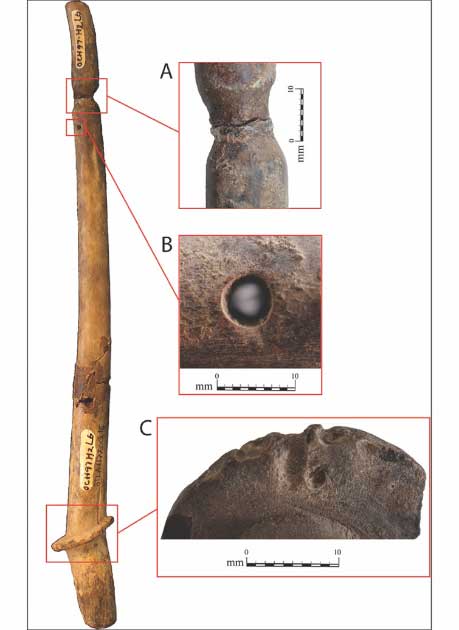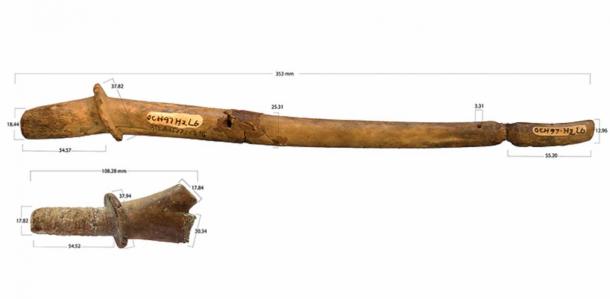
Ancient Deer Antler Instruments Discovered in Vietnam After 3,000 Years
Our prehistoric ancestors were very busy people, but they must have known how to chill in between chores, to relax and recharge. It’s well known to science that our cave dwelling forebears gorged on magic mushrooms and a host of other intoxicating plants. Meanwhile, a 60,000-year-old bear-bone flute discovered in Divje babe cave in Slovenia, demonstrates that the urge to make music and art emerged in deeply-ancient times. Now, a group of researchers studying two ancient deer antlers discovered in Vietnam think they were used to create musical instruments.
These 3,000-year-old deer antler instruments aren’t just simple wind instruments requiring air to make music, but complex stringed instruments with which prehistoric musicians could change pitch and make a range of advanced melodic sounds.

The artifacts are believed to have been used as deer antler instruments. In the image Artifact 1 is compared to other Vietnamese musical instruments such as the b) Bro JoRai, c) Co Ke and d) K’Ny. Source: F. Z. Campos / Antiquity
3,000-Year-Old Deer Antler Instruments: Introducing the Chordophone
The team of scientists comprised researchers from the Research School of Humanities & the Arts at the Australian National University in Canberra, Australia, and the Long An Museum in southern Vietnam. Published in the journal Antiquity, their paper provides an in-depth look at two ancient deer antlers from “an archaeo-musicological perspective.”
- Aztec Death Whistles Sound like Human Screams and May Have Been Used as Psychological Warfare
- Sweet Ancient Melodies of the Ney: One of the Oldest Musical Instruments Still in Use
The two antlers were found among a large collection of human remains kept at the Long An Museum in Tân An City. They were originally recovered during an earlier dig at the Go O Chua archaeological settlement and burial site in southern Vietnam.
The antlers were dated to the pre-Oc Eo and Oc Eo phases which existed some time between 3000 and 1250 BP (before present). According to the study, the two bones were used to create chordophones, which is a type of stringed musical instrument.

Illustration depicting how Artifact 1 would have been used as a deer antler instrument. (F. Z. Campos / Antiquity)
Deer Antler Instruments Unearthed Within Ancient Pagoda Mound
Go O Chua means “Pagoda Mound” and the site is located in the lower Mekong Delta, in the Vam Co Tay River basin, about 100 kilometers (62.13 miles) west-northwest of Ho Chi Minh City. Between 1997 and 2008 both the Go O Chua settlement and burial site was extensively excavated and the new study says the site is defined by three enormous mounds: the northern, central and southern mounds. Together, these three burial structures encompass an area of about 65,000 square meters (699,655 sq ft).
The supposed deer antler instruments were recovered amidst iron and bronze artifacts and layers of animal bones dating back to the pre-Oc Eo phase, which was the earliest occupation at the site. Both deer antler instruments were excavated from the central mound and are conservatively estimated to be 3,000 years old, but might be much older. This makes them “the earliest chordophones found in this region of Vietnam,” according to the paper.

Details of the grooves, holes and notches which led researchers to conclude that the artifacts were once used as deer antler instruments. (F. Z. Campos / Antiquity)
Attaining Full Pitch Control with a Deer Antler Instrument
The interpretation of the deer antlers as musical instruments, or chordophones, was based on several clues. First off, the base of Artifact 1 was found to be slightly flattened with “clearly abraded and slightly polished corners.” It is thought that these wear patterns most likely resulted from the object being placed directly on a hard surface.
The team also speculated that the bone was “held in a player’s lap, or perhaps even on a resonator, and held in a way that movement against the surface on which it was placed resulted in minor abrasion.”
Another clue to Artifact 1’s use as a deer antler instrument and musical nature was provided by “a drilled hole close to the distal groove in the antler beam,” which was found to align with the notch in the burr. It is believed that someone inserted a wooden peg with a string secured around it into this hole, enabling the user to alter the tension on the string, lowering and raising the pitch of the sound.

Both artifacts, which were once used as deer antler instruments for making music, depicted with detailed measurements. (F. Z. Campos / J. R. Hill / Antiquity)
Ancient Musical Traditions in Modern-Day Vietnam
It was the lack of abrasion on Artifact 2 that implied its base was not meant to be seen, “perhaps being covered with a sheath or soft material.” Furthermore, a series of inception lines identified on the base of Artifact 2 might have secured a thick yarn or animal hair cord in place. The researchers said this tiny feature “could have improved stability.”
- The Mysterious Lithophones of Vietnam: Descendants of the First Musical Instruments?
- The Bullroarer: An Instrument That Whirls Through Cultures and Time
In conclusion, after “many apparent similarities in morphology and measurements,” between Artifact 1 and Artifact 2, the team believe they “shared the same function.” And supporting this new musical theory the researchers pointed towards a similarly worked deer antler discovered in 2008 which also “exhibits scrape marks and a smoothed surface on parts of the beam.”
To put these deer antler instruments into context, the 3,000-year-old musical instruments are believed to have worked loosely like the traditional Vietnamese K’ny or K’ni - a bowed monochord musical instrument played among the Bahnar, Jo Rai, Se Dang and Ro ngao of northern and central Vietnam.
DOI: https://doi.org/10.15184/aqy.2022.170.
Top image: The artifacts are believed to have been used as deer antler instruments. Source: F. Z. Campos / Antiquity
By Ashley Cowie















